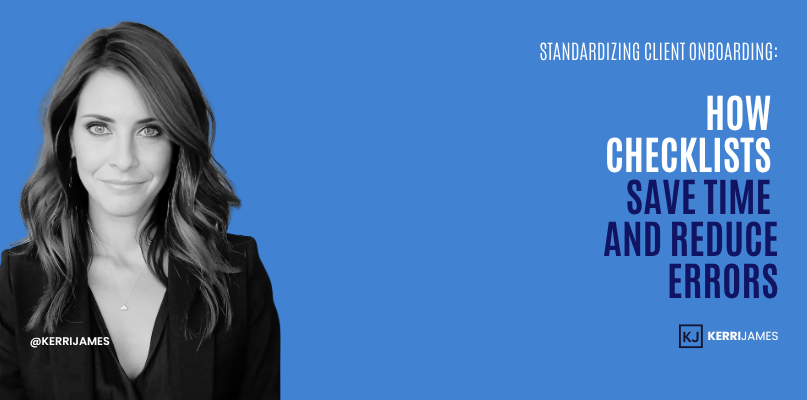Ever felt like you’re walking a tightrope when onboarding new clients? You’re not alone. I remember early on, when our team scrambled to pull everything together for a new client, emails flying, documents scattered, deadlines creeping up like shadows. It was chaos. Everyone was working hard, but we were all out of sync. That’s when it hit me: no matter how talented your team is, without a standardized process, you’re setting yourself and your clients up for unnecessary stress, delays, and costly mistakes.
So, how do you avoid that? One word: checklists. Think about it. Pilots use them. Surgeons rely on them. High-stakes industries build checklists into everything they do because they work. They turn complicated workflows into simple, repeatable steps that anyone can follow whether it’s a seasoned paralegal or a brand-new intake specialist. And when it comes to client onboarding, checklists help ensure nothing falls through the cracks from verifying contact information and signed retainers to triggering internal notifications and prepping the legal team for review.
But beyond logistics, checklists do something deeper: they build trust. Internally, they give your team the confidence to deliver consistently, regardless of who’s handling the task. Externally, they show your clients that you’re organized, responsive, and prepared from day one. That first impression matters. When onboarding is smooth, clients feel taken care of and that experience sets the tone for the rest of the engagement. So no, checklists aren’t just a nice-to-have. They’re essential for saving time, reducing errors, and delivering an outstanding client experience.
Why Standardized Client Onboarding Matters
Think about it: every single client interaction shapes your firm’s reputation. From the very first phone call to the signed retainer and beyond, consistency is what builds trust. A standardized onboarding process ensures that every client, whether they’re your smallest case or your largest, receives the same high level of care and attention. No client wants to feel like they’re getting a second-rate experience just because the team is busy or someone dropped the ball.
But it’s not just about consistency for the client. Standardized onboarding builds internal trust as well. Clients can tell when your process is buttoned-up, and it reassures them that they’ve chosen the right firm. When intake, legal, and admin teams are all following the same client journey map, the experience feels seamless. On top of that, a clear onboarding process boosts internal efficiency. New hires can get up to speed faster with documented workflows and checklists. Your firm can handle more clients without burning out your team or missing critical steps.
Here’s why it matters:
- Efficiency: Streamlined workflows prevent duplicated efforts and eliminate unnecessary back-and-forth between departments. Everyone knows exactly what needs to happen and when.
- Accuracy: Checklists are your best defense against human error. They ensure that no detail, whether it’s a missing signature or a required document, is overlooked. Fewer mistakes mean fewer client frustrations and less time spent fixing issues.
- Client Confidence: A well-structured onboarding process instills confidence. When clients see that your team is organized and proactive, they trust you more, and that trust is the foundation for a strong, lasting relationship.
- Scalability: Whether you have five clients or fifty, a standardized process allows your firm to grow without sacrificing quality. You’ll be able to scale your operations with ease, knowing that each new client will receive the same exceptional experience.
In short, standardization isn’t about rigidity; it’s about reliability. And in today’s competitive legal landscape, that reliability can set your firm apart.
Also Read:
Creating an Intake Workflow That Boosts Efficiency. Learn how a well-designed intake workflow saves time, reduces errors, and gives clients a seamless experience from the very first step.
The Power of Checklists in Onboarding
Checklists are more than boxes to tick; they’re tools that minimize errors and maximize efficiency.
- Reducing Errors: Have you ever missed a document or overlooked a critical client detail? A checklist ensures nothing slips through the cracks.
- Saving Time: When everyone knows exactly what needs to happen and when, you cut down on endless back-and-forth and duplication of efforts.
- Improving Client Experience: Smooth onboarding reduces client anxiety. They see you as professional, organized, and prepared, and that can make all the difference in retention.
- Creating Accountability: Assigning checklist tasks makes it clear who’s responsible for each action, improving team accountability and communication.
Crafting the Ultimate Client Onboarding Checklist
Let’s get practical. You’ve committed to standardizing your onboarding process. Now it’s time to build a robust, efficient client onboarding checklist that’s more than just boxes on a page. This is your roadmap to delivering a seamless, confidence-building experience that sets the tone for everything that follows. Think of it as your blueprint for success, whether you’re onboarding one client this week or twenty.
Step 1: Initial Contact – Setting the Tone Early
The moment a client signs on, the clock starts ticking, and so does their emotional journey. They’ve taken a leap of faith by choosing your firm, and now they need immediate reassurance that they made the right decision. The first 24-48 hours are critical. Here’s what to include in this initial phase:
Send a personalized welcome email
Skip the generic “thank you” auto-reply. Instead, send a thoughtful, branded email that acknowledges their specific situation. Include a sentence or two that speaks directly to their type of case or need. Let them know what to expect in the coming days when they’ll hear from their legal team, what documents they’ll need to provide, and how to reach someone if questions arise. This small gesture builds massive trust.
Provide introductory materials
Include a client welcome packet, digital or physical, that outlines the process ahead. Think FAQs, a visual client journey map, a brief “what happens next” guide, or even a short video introducing your team. This sets clear expectations and positions your firm as organized, professional, and compassionate from day one.
Share contact points
Tell them exactly who they can reach out to and for what. Whether it’s a billing question, an update on their case, or a procedural clarification, clients should never wonder who to call. Listing your primary points of contact by role, intake specialist, paralegal, and attorney, eliminates that uncertainty.
Pro Tip: This is also a great time to reinforce your communication norms. Inform clients about your average response time, preferred communication channels (email vs. phone), and the frequency of regular updates. Setting these boundaries upfront creates a smoother experience for everyone involved.
This is where many firms get bogged down and where client frustration often begins. Nothing undermines confidence faster than endless emails, repetitive questions, or missing documents. The solution? A structured, standardized intake form and straightforward onboarding workflow that ensures you gather the correct information the first time, accurately and completely.
Step 2: Information Gathering – Streamlining the Intake Process
Here’s what to capture at this stage:
Personal and Case Details
Collect comprehensive personal details (full legal name, contact information, date of birth) alongside essential case specifics. Tailor this section to the type of case, personal injury, family law, employment, etc., and include prompts for key details attorneys need during legal review. Pro tip: Have attorneys and paralegals help design this section so the data aligns with what they’ll need downstream.
Relevant Documentation
Request all necessary supporting documents up front, contracts, prior case files, police reports, medical records, identification, and signed releases. List these clearly in your onboarding packet and provide a checklist that the client can reference. This prevents the dreaded “can you send us one more thing” email weeks later.
Preferred Communication Methods and Frequency
Ask clients how they prefer to communicate: phone, email, text message, or client portal. Also, ask how often they want updates. Some clients wish to weekly check-ins, others prefer updates only at key milestones. Capturing this preference early shows respect for the client’s time and expectations, and it makes your team’s job easier when scheduling follow-ups.
Billing Preferences and Signed Agreements
Ensure all billing preferences and retainer agreements are documented, signed, and stored securely. Don’t assume verbal confirmation is enough; build this into your checklist and verify completion before proceeding to case work.
Pro Tip: Use a secure digital platform such as DocuSign, Lawcus, or Clio Grow for document collection and electronic signatures. Nothing screams “disorganized” like asking a client to resend paperwork three times because it got lost in someone’s inbox. Plus, digital workflows create an audit trail and make it easy for your team to track progress in real time.
The information gathering phase is where you set the operational tone for the rest of the case. Do it well, and your team will work more efficiently, your clients will feel taken care of, and your error rates will drop. It’s not just about paperwork; it’s about building trust and momentum from the start.
Step 3: Setting Expectations – Clarity Prevents Misunderstandings
Why Setting Expectations Matters
It’s shocking how often firms skip this step and then wonder why clients get frustrated or anxious down the road. I can’t tell you how many intake reviews I’ve done where excellent teams lost client trust simply because expectations weren’t communicated up front. Clients don’t mind waiting, but they do mind wondering. That’s why setting expectations should be a formal, documented part of your onboarding checklist.
Review Timelines
Walk clients through key milestones in their client journey map. When can they expect updates? What are the major deadlines? How long does each phase of the process typically take? Be realistic and transparent here under promise and overdeliver. If a case typically takes six months to resolve, don’t give the impression it’ll be wrapped up in six weeks.
Define Deliverables
Spell out precisely what your firm will provide and what the client is responsible for. For example:
-
The firm will handle filing deadlines, legal research, and settlement negotiations.
-
The client must provide requested documents promptly and attend scheduled meetings or depositions.
-
Both parties must maintain open and responsive communication.
When everyone knows what’s expected, you avoid those tense “I thought you were taking care of that” moments later on.
Outline Communication
Clarify how and when you’ll communicate. Will updates be sent via email, phone, text message, or through your client portal? How often will your team check in weekly, monthly, or only at major milestones? Inform clients about how to contact their primary points of contact and the expected response time. Pro tip: Reiterate these norms in writing, so there’s no room for misunderstanding.
Include this information in a formal expectations document that the client signs or acknowledges as part of onboarding. Not only does this reinforce trust, it protects your team if disputes arise later about missed communication or unclear responsibilities.
Step 4: Internal Preparation: Aligning Your Team
Behind the scenes, your team needs to align before touching the client’s case. That means:
- Hosting an internal kickoff meeting to assign responsibilities.
- Reviewing the client’s details so everyone understands the nuances.
- Setting up internal project management tools (like Trello or Asana) to track progress.
- Establishing key performance indicators (KPIs) to measure success.
This step isn’t client-facing, but it’s critical. A smooth internal handoff creates a smooth client experience.
Step 5: Kick-off Meeting: Cementing the Relationship
Once the internal prep is done, it’s time for the official kickoff with the client.
- Review the project scope together.
- Confirm expectations and timelines.
- Address any initial concerns.
- Reinforce the value your firm brings to the table.
Here’s the magic: clients want to feel seen and heard. A thoughtful, structured kickoff meeting shows you care about their success, not just their signature.
Step 6: Follow-Up: Keeping the Momentum Going
Onboarding doesn’t end after the kickoff. You need regular, structured follow-ups to:
- Confirm next steps are progressing smoothly.
- Address any issues before they escalate.
- Gather early feedback to fine-tune your approach.
Use automated reminders or calendar tools to schedule these; don’t rely on memory alone.
Tools and Templates to Power Your Checklist
Modern onboarding isn’t just about paper checklists. Here are a few tools to help:
- Trello/Asana for visual project management.
- Clio/Smokeball for legal-specific task management.
- DocuSign/PandaDoc for secure digital signatures.
- Slack/Microsoft Teams for internal communication and file sharing.
Templates can also help standardize documents, ensuring consistency across clients and reducing setup time.
Real-Life Impact: Success Stories
Let me share two stories that showcase the difference checklists can make.
Success Story #1: Scaling Without Breaking
A small firm grew from 20 clients to 60 within a year. Before adopting onboarding checklists, they were swamped, missing deadlines, losing client documents, and dealing with rising complaints. Once they standardized their process, they cut onboarding time by 40%, improved client satisfaction scores, and reduced internal stress.
Cautionary Tale: The High Cost of Chaos
Another firm relied on “mental checklists” and informal processes. When they took on several large clients simultaneously, the situation became unmanageable. Missed deadlines, misfiled contracts, and poor communication led to two major clients walking away, costing the firm over $100,000 in lost revenue and implementing formal checklists after that hard lesson became their top priority.
Implementing Checklists in Your Firm
Ready to make this change? Here’s how to roll it out effectively:
- Train your team: Host workshops or training sessions explaining the why and how of the new process.
- Pilot the checklist by Testing it on a few clients, gathering feedback, and making adjustments.
- Communicate benefits: Show your team how checklists reduce their workload and improve results.
- Commit to continuous improvement: Review and update the checklist regularly. What worked six months ago may need tweaking today.
Advanced Tips: Going Beyond the Basics
If you want to level up, consider:
- Integrating client journey mapping: Visualize every touchpoint from first contact to final invoice to identify gaps.
- Using data analytics: Track metrics like time-to-onboard, error rates, and client satisfaction to measure improvements.
- Automating where possible: Automate repetitive tasks like follow-up emails or document requests to free up human time.
- Personalizing the process: Even a standardized checklist can have room for customization, and tailor communication to match each client’s style.
Conclusion: Why You Should Start Today
Standardizing your client onboarding with checklists is a small change that yields massive benefits: saved time, fewer errors, happier clients, and a more efficient team.
Think of it this way: you wouldn’t build a house without a blueprint. Why run your client relationships without one?
If you’re ready to elevate your firm’s intake game, start building that checklist today. And if you need guidance, check out the resources on KerriJames.co. We’re here to help you transform your processes and deliver intake excellence.









